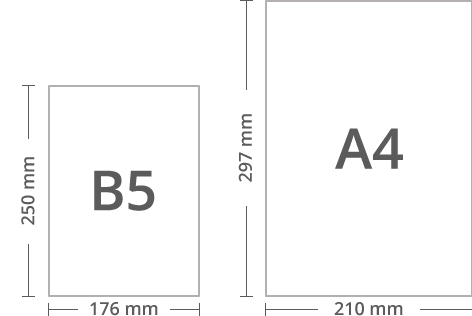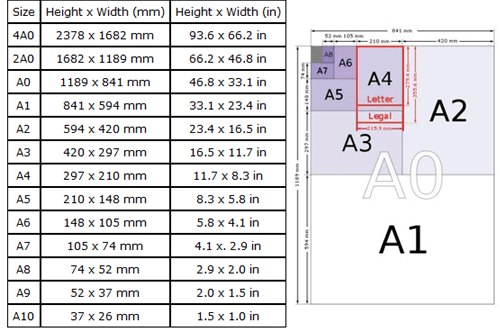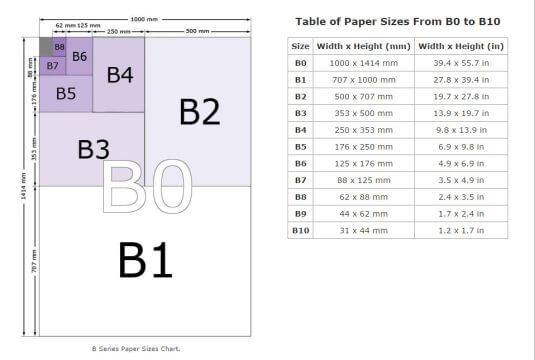
A4 vs B5: What Are the Differences and Uses
Paper comes in different sizes based on the standards of the country. The paper size that is common in the United States may not be available in European countries. Both types of paper are used for printing and writing on paper. Several countries have adopted A4 as the standard size for official documents. This has been done in order to make it easy to exchange documents between different countries.Within the United States, the industry standard seems to be the letter size paper. But if you are an international company, you might want to invest in a size that is commonly used in your country of operation.
Paper size is an important consideration when printing or drafting documents. When it comes to paper size, there are a few different standard sizes that you’re likely to come across. A4 and B5 are two of the most common paper sizes in the world. As a writer, you may think they are both the same size, but they have quite a few differences. This blog will look at the differences of A4 vs B5 to give you better idea of the pros and cons of each paper size.
Size Comparison of A4 and B5

The width of A4 is 210 mm(8.27 inches), which can be compared to the width of a B5 page, which is 177 mm(7 inches). Likewise, the length of an A4 page is 297 mm(11.7 inches) and that of a B5 page is 254 mm(10 inches).
As you can see from the comparison above, an A4 sheet has more surface area than a B5 sheet, although it’s not very much! This can be important when choosing paper sizes for your documents, especially if you want to fill an entire page with text but don’t want to use too small font sizes. For example, on an A4 page if you set your font size at 11 pts then there will be approximately 40 lines per column (assuming 0.6cm margins). On a B5 page however this would decrease to 34 lines per column (assuming 0.7cm margins)! If using larger fonts sizes like 14pts then there should still be space for around 30.
Detail Comparison of A4 vs B5: All Differences Explained
When creating a document that’s going to be printed, you have two sizes to choose from: A4 or B5. You might think that the difference between these two sizes is subtle, and isn’t worth spending your time considering. However, there are many reasons why you should stop to think before you decide which to use. To give you some idea, over 70% of the worlds’ countries use A4 paper as their standard. In the UK, B5 is generally only used in legal documents like bankruptcy petitions and patent specifications. So if you’re thinking about using B5 paper, it’s probably not an option for most purposes!
If you’ve worked on graphic projects that required illustration or photo editing, chances are that at some point in your career, you’ve also run into other paper sizes such as A3 or A1. But why does there seem to be so many different paper sizes? Which one is just right for your business? It doesn’t matter how experienced or professional a designer you are, these questions have probably crossed your mind. The following differences will help you understand the purpose of both types of papers. So you can use the right one for your needs.
Uses of A4 and B5
A4 and B5 both are included in widely used paper formats. A4 sheets are usually used for printing documents and notebooks that are meant to be placed in a binder or file folder. They are also used for flyers, brochures, folders and booklets. On the other hand, B5 papers are suitable for magazine, book production and addressing invitations.
Size
The main difference between the A4 and B5 is their sizes. The A4 has larger dimensions than the B5. The A4 sheet is 210 mm wide and 297 mm long, which is approximately 8.3 x 11.7 inches.
The B5 sheet is 177 mm wide and 254 mm long, which is about 7 x 10 inches (about three-quarters the size of a standard sheet of paper in the United States).
Regions Which Use A4 and B5
The A4 and B5 are two paper sizes that are commonly used in many parts of the world. A4 is more popular than B5, but not by much.
A4 is used in most parts of Europe (excluding Finland, which uses A3), plus many areas in Asia and South America; while B5 is used in Finland, Japan and Korea.
A Series Paper Size

The A series uses an aspect ratio of 1:√2, and other sizes in the series are defined by folding the paper in half, parallel to its smaller sides. For example, cutting an A4 in half, will create two A5 sheets, and so forth. The standard length and width of each size is rounded to the nearest millimeter. A-series paper is widely available throughout the world except in North America, where North American paper sizes such as “Letter” and “Legal” are more common
A Series Paper Sizes :
A0 (841 × 1189 mm), A1 (594 × 841 mm), A2 (420 × 594 mm), A3 (297 × 420 mm), A4 (210 × 297 mm), A5 (148 × 210 mm), A6 (105 × 148 mm), A7 (74 × 105 mm), A8 (52 × 74 mm), A9 (37 × 52 mm), A10 (26 × 37 mm)
ISO 216 specifies tolerances for the production of A series paper sizes as follows:
±1.5 mm (0.06 in) for dimensions up to 150 mm (5.9 in)
±2 mm (0.08 in) for lengths in the range 150 to 600 mm (5.9 to 24 in)
±3 mm (0.12 in) for any dimension above 600 mm (24 in).
B series Paper Size

The B series paper sizes were introduced to provide an alternative to the similar American system based on Letter, Legal and other sizes. The most commonly used formats are B3, B4, B5 and B7. The aspect ratio of the B series sheets is 1:√2 (1 to root 2).
The Japanese use B3 for posters, Manga magazines (Japanese comics) and newspapers. Many blueprints are printed on B4 format paper. Stationery items such as envelopes and notepads are often found in the B5 format.
B series is defined as the geometric mean of A series. Which means that B1 is between A0 and A1.
B Series Paper Sizes:
B0 (1000 × 1414 mm), B1 (707 × 1000 mm), B2 (500 × 707 mm), B3 (353 × 500 mm), B4 (250 × 353 mm), B5 (176 × 250 mm), B6 (125 × 176 mm), B7 (88 × 125 mm), B8 (62 × 88 mm), B9 (44 × 62 mm)
How to choose a paper size?
When you have to print your document, you need to choose the right paper size and if your device allows you to choose a custom paper size, then you have to decide which ratio is best for your document. The classic is the A4 format, but sometimes this does not fit what we want to do. When it comes time to choose a paper size, you need to consider more than just the minimum printable area.
If you’re printing a single-page document, such as a letter or a recipe, US Letter (8.5″ x 11″) is the perfect choice if you’re in North America. However, If you’re in Europe or Australia, A4 is more common.
If you have something that needs folding, like an invitation or newsletter, you might choose a larger size so it folds down to a smaller size that fits easily in an envelope. For example, an 8 page booklet printed on 11″ x 17″ paper can be folded down to fit into an A5 envelope.
The availability of the paper is also important. If you’re using a desktop printer at home, you might be limited to certain sizes that are easy to load into your printer tray without having to change the paper all the time. In contrast, professional printers usually have large stacks of paper in many different sizes and can handle almost anything you send them.
Letter size vs a4
A4 is the most common paper size used in the world today. We use it for documents, reports, brochures and lots of other printed items. However, America still uses Letter format which is slightly different in size.
A4 is the international standard for paper sizes. Letter is standard in the United States, Canada and a few other places. A4 is 210mm by 297mm (about 8 1/4 inches by 11 2/3 inches). Letter is 8 1/2 inches by 11 inches. This means that when you take an A4 sheet of paper and fold it in half, it will fit into a C5 envelope. When you take a Letter sheet of paper and fold it in half, it will fit into a C6 envelope. The difference may seem small, but it’s enough to make life difficult if you’re trying to print an A4 document on letter size paper.
A4 has become the standard size for most printers because both sides of the paper can be used. But computers still use pixels as their basic unit of measure although they do have a resolution measured in dots per inch (DPI). Because computer screens don’t have fixed sizes, computer users also often use millimeters to measure screen elements. This can get confusing if you’re using both units on your computer screen and then switching to inches for your printer output.
Frequently Asked Questions
What is A4 paper?
A4 paper is a standard sized sheet of paper used for typing documents and printing. These are the most common size used in offices around the world, but some countries use different sizes.
A4 paper is commonly known as letterhead in the United States and Canada. Although it has different dimensions than US letter-size paper (8.5″ x 11″), it can be used with US stationary by setting the printer to fit the document to the page.
What is B5 paper?
B5 paper is part of the ISO 216 paper size standard. Introduced in 1975, the standard defines the most frequently used paper sizes; the B series is mainly used to define media sizes such as envelopes, postcards, mailing cards, books, magazines and folders.
The B5 size is between A4 and A5 in size, thus making it a popular choice for magazines and notebooks as you can fit more pages in a smaller space than on A4 paper with a similar page size as on A5 paper.
What is the difference between US standard paper size and A4 standard size?
The difference between US standard paper size and A4 standard size is that the US standard paper size has a width of 8.5 inches and a height of 11 inches whereas the A4 standard size has a width of 210 mm and a height of 297 mm.
Is B5 bigger than A4?
No, B5 is not bigger than A4.
Is half of A4 B5?
No. The “A” series paper sizes are based on a constant width to length ratio of 1:√2. Half an A4 sheet is not the same size as a B5 sheet
Which paper size is right for comics and illustrations?
The most common sizes used for comics and illustrations today are 8.5″ x 11″ (or 11″ x 17″) and A4 (which is close to 8.25″ x 11.75″).
The size of your paper will depend on how you plan on printing your work. If you are planning on taking your artwork to a print shop, you may want to go with their standard paper size. If you’re planning on printing your art yourself, A4 is the most common size for home printers, but check your printer specs to make sure it can handle the larger 11″x17″ paper if that’s what you prefer.
Is A4 paper size the same as legal?
The answer is no. While both are used by people in different countries, A4 paper size is used by most of the world. Legal paper size is used only in the United States and Canada. You can compare both here.
- What Are Ink Subscriptions? - December 12, 2022
- How To Get a Gel Pen To Work Again - December 12, 2022
- Best Pens For Teachers - December 11, 2022